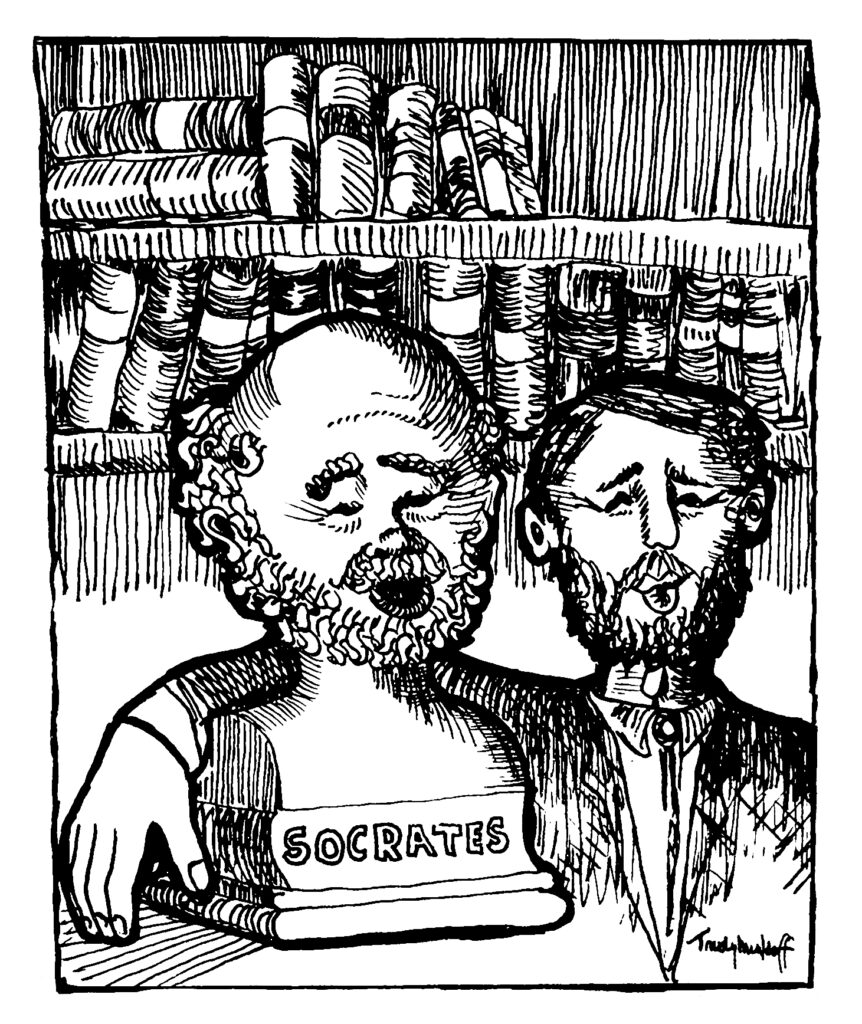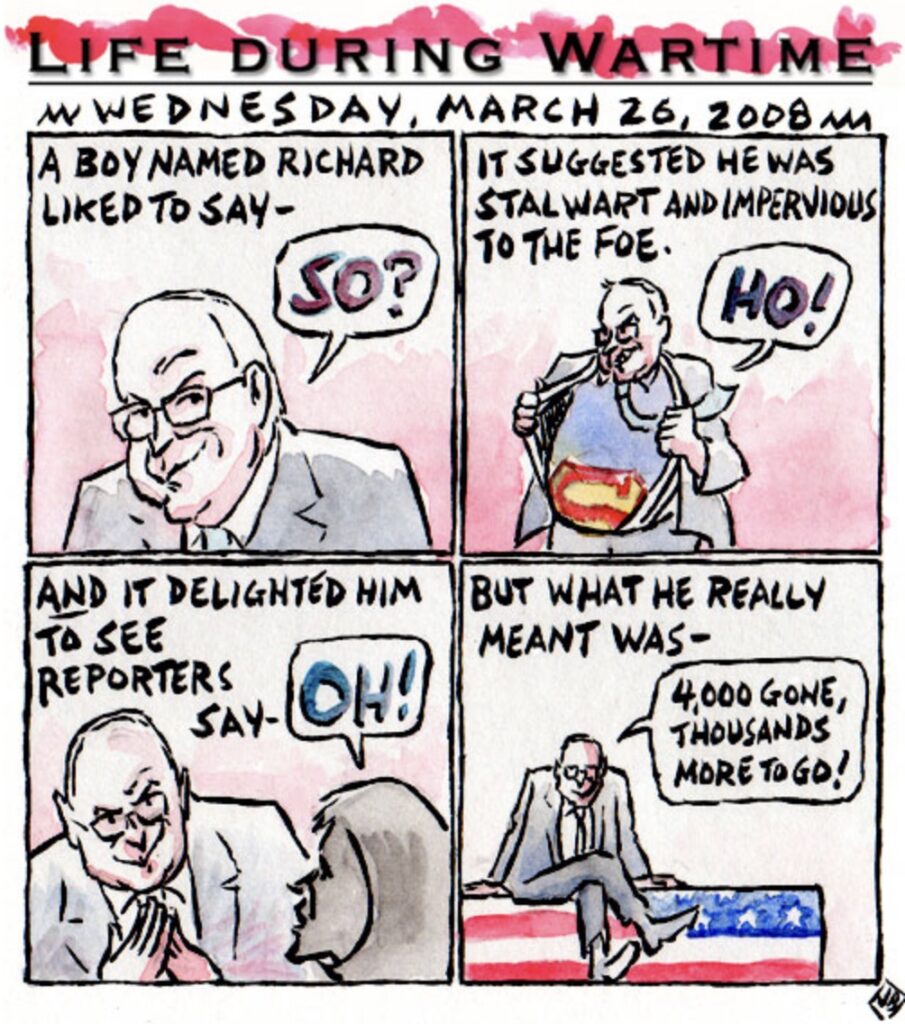
By Martin J. Murray / The Rag Blog / December 4, 2025
I knew Larry Caroline for only a few short years in Austin. It was a memorable experience. My first recollection of Larry was at the Capitol Building around October 10, 1967. This tall, lanky guy with a big beard got up to speak. He put into words what I knew but could not articulate clearly. The guy — Larry — went through a long list of “wrongs” in America, persistent racial injustice, continued segregation in the South, corporate greed, political indifference. He said “you can’t change things one at a time. The whole bloody mess (using a British phrase) has to go. Then more.
Wow. He put into words what I was thinking but was unable to articulate.
Soon after, I started going to SDS meetings. I saw Larry in action. He could formulate an argument so quickly. What I remember in watching him in dialogue with young people who did not share his views that he was never demeaning, dismissive, or arrogant. He showed with rational rigor the “wrongness” of their ideas defending capitalism and the war. I have never forgotten his style of debate and have tried to emulate it ever since. Disarm your critics but never demean them as persons.
Larry was part of the “big three”: slightly older men whom I admired. Martin Wiginton was the ultimate tactician — focusing on what to do in building demonstrations. Greg Calvert was the strategist, thinking beyond the antiwar movement about how to build coalitions to challenge capitalism and its war fever. Larry was the great thinker, using rational thought and logic to work through big problems.
In Larry’s last term in the Philosophy Department (I believe Spring term 1969), I was his teaching assistant. What a joy. I got to hear his lectures the whole semester. He was so smart
Frank Erwin was, of course, the Grand Inquisitor. But John Silber was his handyman. Greg Calvert once likened Silber to the famous quote about Talleyrand –“he’s nothing but shit in silk stockings.”
Larry was done such a great disservice by Erwin, Silber, and the leadership of the Philosophy department. Through it all, Larry maintained a high public profile.
In the time I spent with Larry before he started working at the alternative school Greenbriar, I learned how to think. I read his dissertation chapter named “Why be Moral?” It was so informed and erudite.
His legacy for me is straightforward: he got me to think and to be kind to others, even when we disagree with them.
Martin J. Murray is the author of Insurgent Politics in the Lone Star State: Remembering the Antiwar Movement in Austin, Texas, 1967-1973.
Rag Blog Afterword
Larry Caroline passed away on November 7, 2025. He was 85. An obituary shared by Larry Caroline’s family recounts his early life:
Born in upstate New York, Yisrael (Larry) grew up in a Yiddish-speaking home that valued Jewish identity but was not observant. The experience of facing discrimination as a Jewish child awakened in him a lifelong drive to stand up for those who were mistreated.
While studying philosophy at the University of Rochester, he became president of the NAACP chapter and a leader in the campus movement for civil rights. He organized protests against racist fraternities and became an outspoken advocate for equality and peace. His early ideals, deeply rooted in justice and moral clarity, shaped his work as a professor and public speaker.
After earning a fellowship from the Woodrow Wilson Foundation, he taught at Kentucky State College during the civil rights struggle. Later, as a professor at the University of Texas, he became known for his passionate opposition to the Vietnam War. His remarks at a protest rally, calling for “a revolution” to end the war, made front-page news across Texas and ultimately led to his dismissal from the university.
Barbara Hines, who was featured along with Judy Smith in the documentary Lone Star Three, shared this memory with The Rag Blog: “Larry’s philosophy course in the spring of 1969 made such an impact in my life. Introducing me to Herbert Marcuse and Judy Smith.”







































MICHAEL MEEROPOL / COMMENTARY / Sleeping Giant: Thoughts on the results of the November 4 elections
Image from Pix4Free.org.
By Michael Meeropol / The Rag Blog / November 18, 2025
The following is an expanded version of a commentary delivered over WAMC-FM on November 7, 2025, by Michael Meeropol, Professor Emeritus of Economics at Western New England University. It has been edited for The Rag Blog. Meeropol and Alice Embree will be featured on Thorne Dreyer’s Rag Radio program on KOOP 91.7-FM in Austin and streamed at KOOP.org, Friday, Nov. 21, at 2 p.m. to discuss this article and larger issues it raises.
I stayed up to watch the election results and was rewarded with evidence that the “sleeping giant” — the American people — had finally awakened to the danger that Trump and Trumpism poses to our society. Yes, I saw the exit polls. Most people claimed to be voting in favor of the candidate they voted for, not “against” anyone. Yes, in two of the three major elections, the governorships of Virginia and New Jersey were won by so-called “moderates” — two “national security women.” (Governor–elect Spanberger of Virginia served in the CIA before getting into politics. Governor-elect Sherrill of New Jersey is a former Navy helicopter pilot who had graduated from the US Naval Academy.)
But I believe despite what voters told pollsters, there was an underlying goal for many of the people who came out to vote — and that was to “vote against Trump.” The candidates running did not have to say it — the people answering pollsters did not want to say it. But I believe that, for example, the people standing in line for hours in California to pass a ballot measure that they were very confident would pass without their votes — when there was no one on the ballot! — were there to make a statement against Trump and as one person told a reporter, voted “in defense of my freedom.”
Meanwhile, the election of a Democratic socialist in New York City who brought out a hundred thousand young people who had never voted and probably wouldn’t have voted if he hadn’t been in the race has been considered an anomaly. And this attempt to dismiss his victory as something totally impossible to replicate anywhere else has occurred despite the fact that he had to battle unbelievably strong headwinds. Once he won the primary, literally millions of dollars were spent by billionaires attempting to smear him as badly as any red baiters did in the McCarthy era.
The fact that Trump routinely called him a communist means almost nothing. But the attempts to smear him as a radical Muslim – even hinting he would have celebrated 9-11 — did produce a fear in too many Jewish New Yorkers that the city would no longer be safe for them should he win. And this, of course, was despite the fact that he won the vote of young Jews. Meanwhile, his campaign was focused like a laser on economic issues — which also had pride of place in the two gubernatorial campaigns.
And to return to the Virginia campaign, the Republican candidate for governor spent a tremendous amount of money running ads attacking trans kids in sports and bathrooms. According to a Substack entitled Erin in the Morning [Check out “A Stunning Rebuke Of Anti-Trans Politics”—Dems Win Elections Nationwide Despite Anti-Trans Ads.]
“According to MSNBC, more than 57 percent of Republican ad spending in the Virginia governor’s race went toward anti-transgender messaging, an effort to revive what the party saw as a winning wedge issue in 2024. But a year later, with prices still high and anti-trans rhetoric solving none of voters’ real problems, the strategy appeared to backfire. Voters seemed tired of the culture wars and frustrated that Republicans remained fixated on scapegoating instead of governing.”
Both Democratic candidates for governor stressed economic issues in their campaigns — just as did Mamdani. Meanwhile, in Pennsylvania, three judges on the State Supreme Court were up for their 10-year “re-election” where the vote was Yes (keep them for another 10 years) or No (send them off the bench). A very clever set of ads made it seem that voting “no” was a way of protecting the integrity of voting in Pennsylvania. In fact, knocking off these three judges would have created a right-wing majority which would have been ready to rule in favor of whatever ridiculous challenge Republicans would mount to steal the 2026 and/or 2028 elections. All three campaigns went down to ignominious defeat.
And in California as I already mentioned, people waited in line for over an hour to vote for an idea, Proposition 50, which changed the State Constitution giving the Governor and State Legislature the power to increase the number of Democratic majority districts in California by five — matching exactly what the state of Texas did at Trump’s bidding — adding five Republican seats.
What does this mean? I saw one poll out of hundreds that tells it all. Thirty percent of the population told pollsters they identified as MAGA — that is the Trumpified Republican Party — the people who waved signs at the Republican Convention calling for mass deportation — the people who have rushed to join the newly militarized ICE so they can snatch people with brown skin off the streets without warrants or accountability].
Guess what? The same poll asked how many people identified with the No Kings protests. That number was 43 percent. Given that the No Kings movement has no national leadership — no nationally known face of the leadership — no agreed upon principles beyond defending American democracy against Donald Trump and his fascists and has gotten very slight coverage from lots of the national media — that number is remarkable.
[For details see https://www.msnbc.com/rachel-maddow-show/maddowblog/poll-shows-no-kings-protest-movement-topping-maga-public-support-rcna241803
It is particularly remarkable because the Speaker of the House was all over national television calling the No Kings rallies “hate America” events and attacking the participants as Hamas supporters, terrorists, supporters of political violence and communists. (Not sure I got all his epithets but people can look it up!). The attack lines of Trump and his Trumpists did not work for that 43 percent and I consider that remarkable as well.
I am convinced that the reason the elections were blowouts is because the energy generated by the giant crowds at the No Kings Day protests carried over to election day. So many people at these rallies asked each other and the speakers what can we do? It is easy to give money. It is (relatively) easy to write a letter to an editor. It is harder to take a drive and stand in a crowd for a few hours with a sign. It is much harder to knock on doors for your preferred candidate. Yet thousands of people — in New York thousands of young people — did just that for the New York Mayoral candidate who Trump called a communist as well as for the two Democrats in Virginia and New Jersey. And in California, people waited in line for over an hour for an idea — proposition 50 — in California.
America is back. But — now is not the time to rest on our laurels. These blowout elections are validation of all the work that’s been done exposing the atrocities of the Trump Administration and making sure at least the majority of the public sees through the administration’s lies. But it is almost a full year to the 2026 midterms. A lot can happen in that time. It is essential that the people keep coming out to demonstrations and rallying around support for our immigrant neighbors targeted by ICE.
More importantly, lawyers, officials, etc., have to prepare to fight Trump’s and the Republicans’ attempts to steal the 2026 election. We know they are planning to do that — only massive voter turnouts and massive vote margins will stop them — as will courts like the Pennsylvania Supreme Court.
The people have demonstrated they understand the threats to our democracy posed by Trump and his enablers — we just have to keep it up for at least the next year.